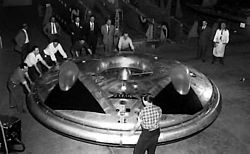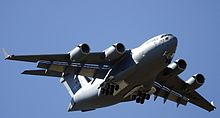- Coandă effect
-
 Venturi and Coandă effect
Venturi and Coandă effect
The Coandă effect
 /ˈkwɑːndə/ is the tendency of a fluid jet to be attracted to a nearby surface.[1] The principle was named after Romanian aerodynamics pioneer Henri Coandă, who was the first to recognize the practical application of the phenomenon in aircraft development.
/ˈkwɑːndə/ is the tendency of a fluid jet to be attracted to a nearby surface.[1] The principle was named after Romanian aerodynamics pioneer Henri Coandă, who was the first to recognize the practical application of the phenomenon in aircraft development.Contents
Discovery
An early description of this phenomenon was provided by Thomas Young in a lecture given to The Royal Society in 1800:
The lateral pressure which urges the flame of a candle towards the stream of air from a blowpipe is probably exactly similar to that pressure which eases the inflexion of a current of air near an obstacle. Mark the dimple which a slender stream of air makes on the surface of water. Bring a convex body into contact with the side of the stream and the place of the dimple will immediately show the current is deflected towards the body; and if the body be at liberty to move in every direction it will be urged towards the current.[2]
A hundred years later, Henri Coandă identified an application of the effect during experiments with his Coandă-1910 aircraft which mounted an unusual engine designed by Coandă. The motor-driven turbine pushed hot air rearward, and Coanda noticed that the airflow was attracted to nearby surfaces. He discussed this matter with leading aerodynamicist Theodore von Kármán who named it the Coandă effect.[3] In 1934 Coandă obtained a patent in France for a "Method and apparatus for deviation of a fluid into another fluid". The effect was described as the "Deviation of a plan jet of a fluid that penetrates another fluid in the vicinity of a convex wall."
Causes
The Coandă effect is a result of entrainment of ambient fluid around the fluid jet. When a nearby wall does not allow the surrounding fluid to be pulled inwards towards the jet (i.e. to be entrained), the jet moves towards the wall instead. The fluid of the jet and the surrounding fluid should be essentially the same substance (a gas jet into a body of gas or a liquid jet into a body of liquid). In one application, a jet of air is blown over the upper surface of an airfoil, which can have a strong influence on the overall lift, especially at high angles of attack when the flow would otherwise separate (stall). See Blown flap.
Applications
The Coandă effect has important applications in various high-lift devices on aircraft, where air moving over the wing can be "bent down" towards the ground using flaps and a jet sheet blowing over the curved surface of the top of the wing. The bending of the flow results in its acceleration and as a result of Bernoulli's principle pressure is decreased; aerodynamic lift is increased. The flow from a high speed jet engine mounted in a pod over the wing produces enhanced lift by dramatically increasing the velocity gradient in the shear flow in the boundary layer. In this velocity gradient particles are blown away from the surface, thus lowering the pressure there. Closely following the work of Coandă on applications of his research, and in particular the work on his "Aerodina Lenticulară,"[4] John Frost of Avro Canada also spent considerable time researching the effect, leading to a series of "inside out" hovercraft-like aircraft where the air exited in a ring around the outside of the aircraft and was directed by being "attached" to a flap-like ring.
This is as opposed to a traditional hovercraft design, in which the air is blown into a central area, the plenum, and directed down with the use of a fabric "skirt". Only one of Frost's designs was ever built, the Avrocar.
The VZ-9 AV Avrocar (often listed as VZ-9) was a Canadian vertical takeoff and landing (VTOL) aircraft developed by Avro Aircraft Ltd. as part of a secret U.S. military project carried out in the early years of the Cold War.[5] The Avrocar intended to exploit the Coandă effect to provide lift and thrust from a single "turborotor" blowing exhaust out the rim of the disk-shaped aircraft to provide anticipated VTOL-like performance. In the air, it would have resembled a flying saucer. Two prototypes were built as "proof-of-concept" test vehicles for a more advanced USAF fighter and also for a U.S. Army tactical combat aircraft requirement.[6]
The effect was also implemented during the U.S. Air Force's AMST project. Several aircraft, notably the Boeing YC-14 (the first modern type to exploit the effect), have been built to take advantage of this effect, by mounting turbofans on the top of wing to provide high-speed air even at low flying speeds, but to date only one aircraft has gone into production using this system to a major degree, the Antonov An-72 'Coaler'.
The McDonnell Douglas YC-15 and its successor, the Boeing C-17 Globemaster III, also employ the effect. The NOTAR helicopter replaces the conventional propeller tail rotor with a Coandă effect tail.
An important practical use of the Coandă effect is for inclined hydropower screens,[7] which separate debris, fish, etc., otherwise in the input flow to the turbines. Due to the slope, the debris falls from the screens without mechanical clearing, and due to the wires of the screen optimizing the Coandă effect, the water flows though the screen to the penstocks leading the water to the turbines.
The Coandă effect is also used to make automotive windshield washers which function without moving parts and to create pneumatic logic circuits.[8]
The operation principle of oscillatory flowmeters also relies on the Coandă phenomenon. The incoming liquid enters a chamber that contains 2 "islands". Due to the Coandă effect the main stream splits up and goes under one of the islands. This flow then feeds itself back into the main stream making it split up again, but in the direction of the second isle. This process repeats itself as long as the liquid circulates the chamber, resulting in a self induced oscillation that is directly proportional to the velocity of the liquid and consequently the volume of substance flowing through the meter. A sensor picks up the frequency of this oscillations and transforms it into an analog signal yielding volume passing through.[9]
In air conditioning the Coandă effect is exploited to increase the throw of a ceiling mounted diffuser. Because the Coandă effect causes air discharged from the diffuser to "stick" to the ceiling, it travels farther before dropping for the same discharge velocity than it would if the diffuser was mounted in free air, without the neighbouring ceiling. Lower discharge velocity means lower noise levels and, in the case of variable air volume (VAV) air conditioning systems, permits greater turn-down ratios. Linear diffusers and slot diffusers that present a greater length of contact with the ceiling exhibit greater Coandă effect.
In cardiovascular medicine, the Coandă effect accounts for the separate streams of blood in the fetal right atrium.[10] It also explains why eccentric mitral regurgitation jets are attracted and dispersed along adjacent left atrial wall surfaces (so called "wall-hugging jets" as seen on echocardiographic color-doppler interrogation). This is clinically relevant because the visual area (and thus severity) of these eccentric wall-hugging jets is often underestimated compared to the more readily apparent central jets. In these cases, volumetric methods such as the proximal isovelocity surface area (PISA) method are preferred to quantify the severity of mitral regurgitation.
The Coandă effect is used in medicine as a ventilator.[11][12][13]
In meteorology, the Coandă effect theory has also been applied to some air streams flowing out of mountain ranges such as the Carpathian Mountains and Transylvanian Alps, where effects on agriculture and vegetation have been noted. It also appears to be an effect in the Rhone Valley in France and near Big Delta in Alaska.[14]
Demonstration
The Coandă effect can be demonstrated by directing a small jet of air upwards at an angle over a ping pong ball. The jet is drawn to the upper surface and curves around, diverting the flow downwards over the back. This change in the momentum of the air flow is reacted out in the reduced pressure on the upper surface of the ball, this suction being sufficient to overcome the weight of the ball (when there is enough air flow). This demonstration can be performed using a vacuum cleaner if the outlet can be attached to the pipe and aimed upwards at an angle.
A common misconception is that Coandă effect is demonstrated when a stream of tap water flows over the back of a spoon held lightly in the stream and the spoon is pulled into the stream. While the flow looks very similar to the air flow over the ping pong ball above (if one could see the air flow), the cause is not really the Coandă effect. Here, because it is a flow of water into air, there is little entrainment of the surrounding fluid (the air) into the jet (the stream of water). This particular demonstration is dominated by surface tension.
Another demonstration is to direct the air flow from, e.g., a vacuum cleaner operating in reverse, tangentially past a round cylinder. A waste basket works well. The air flow seems to "wrap around" the cylinder and can be detected at more than 180° from the incoming flow. Under the right conditions, flow rate, weight of the cylinder, smoothness of the surface it sits on, the cylinder will actually move. Note that the cylinder will not move directly into the flow as a misapplication of the Bernoulli effect would predict, but at a diagonal.
The effect can also be seen by placing a can in front of a lit candle. If one blows directly at the can, the air will bend around it and extinguish the candle.
If two lit candles are placed side-by-side, the heated air from each candle rises and entrains surrounding air. Since both "jets" are trying to entrain common air from the space between the two streams, they are drawn towards one another. This is more apparent if the candles are making a little smoke. This is a demonstration of the Coandă effect without the presence of any surface. In some sense, the plane of symmetry between the two flows can be thought of as the surface.
Problems caused
The Coandă effect has disadvantages as well as advantages.
In marine propulsion, the efficiency of a propeller or thruster can be severely curtailed by the Coandă effect. The force on the vessel generated by a propeller is a function of the speed, volume and direction of the water jet leaving the propeller. Under certain conditions (e.g. when a ship moves through water) the Coandă effect changes the direction of a propeller jet, causing it to follow the shape of the ship's hull. The side force from a tunnel thruster at the bow of a ship decreases rapidly with forward speed. [15] The side thrust may completely disappear at speeds above about 3 knots. [16]
See also
- Aerodynamics
- Airfoil
- Fluid dynamics
- Boundary layer
- Fluid friction
- Circulation control wing
- Lift (force)
- Magnus effect
- Trench effect
References
- ^ Tritton, D.J., Physical Fluid Dynamics, Van Nostrand Reinhold, 1977 (reprinted 1980), Section 22.7, The Coanda Effect.
- ^ Young, T. (1800), Outlines of experiments and inquiries, respecting sound and light.
- ^ Eisner, Thomas (2005), For Love of Insects, Harvard University Press, p. 177, ISBN 0674018273, http://books.google.com/books?id=Ki9djoKOm-0C&pg=PA177
- ^ http://www.phys.ttu.edu/~cmyles/Phys5306/Talks/2004/Fluid%20Dynamics.ppt, Fluid Dynamics by Mihaela-Maria Tanasescu, Texas Tech University
- ^ Yenne 2003, pp. 281–283.
- ^ Milberry 1979, p. 137.
- ^ Hydropower in the U.S., Coandă effect used in debris screen design.
- ^ US 4210283 "Dual pattern windshield washer nozzle"
- ^ Spitzer, David W. "Industrial Flow measurement". Instrument Society of America, 1990.
- ^ Ashrafian H. The Coandă effect and preferential right atrial streaming. Chest. 2006 Jul;130(1):300.
- ^ http://bja.oxfordjournals.org/content/100/6/859.full
- ^ http://medical-dictionary.thefreedictionary.com/fluidic+ventilator
- ^ http://www.japi.org/june_2009/16_MP_Anaestheisa_and_Critical_Care.pdf
- ^ Giles, B.D. Fluidics, The Coandă Effect, and some orographic winds. Arch.Met.Geoph.Biokl. Ser.A. 25, 1977, 273-279
- ^ Lehn, E. (1992), Practical methods for estimation of thrust losses, Trondheim, Norway: Marintek (Norwegian Marine Technology Research Institute), report number 513003.00.06
- ^ Clarke, I. C. (2005), Ship Dynamics for Mariners, London: The Nautical Institute
External links
Categories:- Boundary layers
- Aerodynamics
- Physical phenomena
- Henri Coandă
Wikimedia Foundation. 2010.


